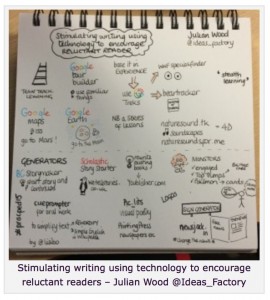Overview
Effective note-taking is a vital skill for students, but by no means a simple one to teach or to learn. From my experience, students have to be constantly reminded to take notes during a reading, a lecture or whilst watching a video documentary. They then either take such detailed, undiscriminating notes that they miss the ‘big picture’, or make such brief and unfocused points that they serve no useful purpose whatsoever.
The following strategies are ones which I am currently planning to try out with my students in the coming weeks: I plan to provide students with a range of possible note-taking strategies, and let them feed back to me on which ones they think work best before developing this blogpost with further ideas and reflections.
NOTE:
Some of these methods are clearly ‘note-taking’ strategies to be used during the lesson itself.
Others are ‘note-transformation’ strategies to be used when re-drafting after the lesson.
At the start of the lesson, the best approach is therefore to encourage students to identify the most effective note-taking strategy, and consider in advance what format they intend to transform these notes into after the lesson.
A. Note-taking methods suitable both for lectures and for readings
Four Box Limit
Tell students to divide their paper into four sections. If the lesson is based around a text-reading, they have to identify the main points made in the piece and write these into each box. Alternatively, if this is a teacher-led lecture, these headings might be provided by the teacher at the start of the lesson. In this way students are limited in how much space they have to write their notes. This means that they avoid simply writing things down passively and verbatim and they are more motivated to transform their notes into something more useful after the lesson.
AutoShapes
When Amjad Ali (@astsupportaali) visited our school a few months ago, he outlined how he gives each student a sheet of A3 paper packed with random shapes (added in Microsoft Word using the ‘callout’ and ‘auto shape’ functions – see picture). He then tells the students that their task is to fill the shapes with notes during the course of the activity. According to Amjad, the simple act of providing the shapes makes the act of note-taking more manageable and fun than simply providing students with a vast sheet of blank paper.
Concept Maps
A more structured approach than the ‘Autoshapes’ technique, this method encourages students to break the material down into key points, secondary points and substantiating evidence. This is best suggested to students as something that they will transform their initial notes into after the session. It thereby provides them with more focus during the initial note-taking phase.
Cornell Note-Taking Method
The Cornell Method involves dividing up notes into 3 sections as shown below. Key points / questions are made in the left-hand column, and substantiating evidence / answers are provided on the right either during the lecture or directly afterwards. Following the lesson, a summary is written at the bottom of the sheet.
B. Methods suitable for reading-based tasks
The following methods are specifically suited for tasks involving close reading at the students’ own pace. In that sense they promote close reading of a text. They also overlap the ‘live’ note-taking strategies listed above, and the ‘second-draft’ note-transformation strategies listed below.
One Post-It Per Page
When students are taking notes from a book, provide each student with some Post-It notes. They can only make notes on these, and can only include one Post-It note on each page of the book to summarise its essential message (you can of course change this rule to one Post-It note per paragraph if this is more appropriate). These can simply be left in the reading if it is the students’ own copy; if they need to be removed then an appropriate citation should be written on the reverse of each note before they are removed and collated – they could even be stuck together with a ‘covering’ note to create a ‘miniature book’ entitled ‘A gnome’s guide to…’! These could certainly form the basis of an interesting display…
If this is the question, what is the answer?
In this method, students number each paragraph of the text. They then read each paragraph carefully and identify what question it appears to answer. Their notes then take the format of three columns: (a) The paragraph number; (b) The question this paragraph answers and (c) The answer to that question using the key evidence in that paragraph.
C. Note-Transformation Methods
Sketch-noting

At the recent Practical Pedagogies Conference hosted here at the International School of Toulouse, I was intrigued that a number of the teacher delegates and workshop leaders were busy taking notes surrounded by a vast array of coloured pens. The King of Sketch-noting during the conference was probably Mark Shillitoe (@markshillitoe – see his blogpost and superb sketch-notes here), and the Queen was most certainly Lisa Stevens (@lisibo – see her sketch-notes here), who told me that she finds ‘doodling’ her thoughts in this way much more productive and useful than making traditional ‘linear’ notes. As a bit of a doodler myself, this is an approach I am going to be adopting myself. I like the idea of encouraging students to adopt this method too if it suits them – the results can be visually stunning and they summarise the key points in a very immediate and accessible way. One example of Lisa’s sketch-notes is shown to the right (taken during the workshop led by Julian Wood (@ideas_factory).
Five-Finger Summary
Get students to trace the outline of their hand on a piece of paper. Across the palm, write the central question answered by the text. On each finger, provide a key point made in answer to that question. For further development, the ‘hand’ can be cut out and on the reverse side a key piece of evidence can be added to each finger as substantiating detail for the point made.
6-Step Story
Tell students before the note-taking starts that their objective after making their notes will be to select what they consider to be the six key points that were made. Each one of these will then be summarised as the title of a separate box (a simple table of 3X2 will suffice). Underneath each title, preferably in a different colour, the substantiating evidence for the point should be included. As a final visual step, each box could then be given an associated image which can be overlaid over the box to create an ‘open-me’ display piece.
Telescopic Topics
Students could also create notes in the form of an indented list. I developed the ClassTools “Telescopic Topic” generator to provide an interactive version of such notes, which look like this:


